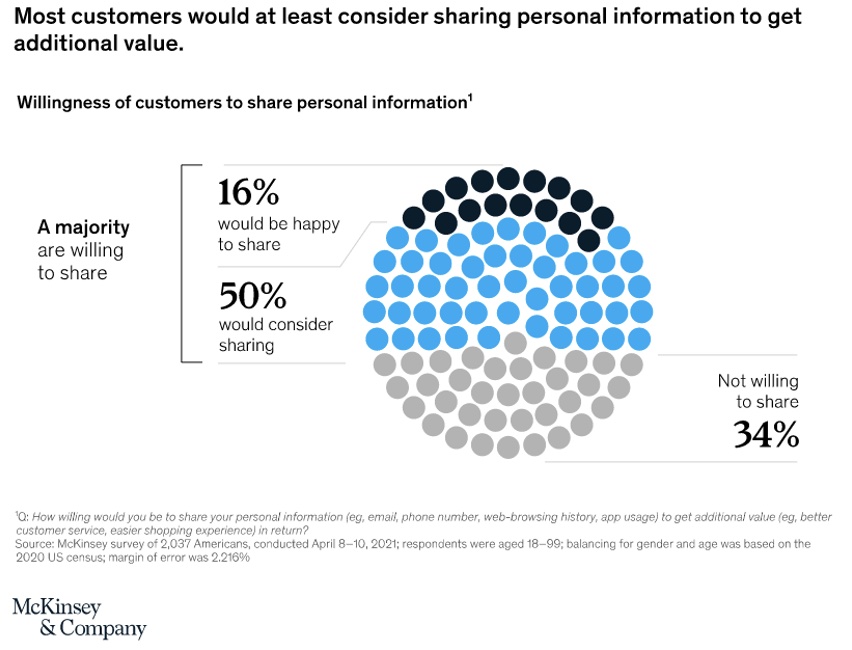Retailers are always looking for ways to maximize customer interactions and develop new revenue opportunities, particularly in the face of social and economic challenges. Retail media networks (RMNs) have recently emerged as an attractive investment option for retailers and brands or consumer packaged goods (CPG) companies.
Retail media refers to how retailers can use their onsite and offsite channels to offer advertising opportunities for partners powered by consumers’ first-party data.
Examples of retail media channels are:
- Onsite digital: Retailer's mobile app and website/domains.
- Offsite: Social media and partners like Facebook, Google and Pinterest.
- In-store: Shelf divider, vision floor sticker, a digital screen.
- Sampling: Delivery samples to selected customers that order online or collect.
- Magazine: Ads placed at the retail-owned magazine.
- Coupons: Ads and special coupon campaigns.
Although some retailers are still apprehensive, we’ll explore why retail media networks are growing in popularity and why they can be a sound investment for organizations.
1. It's a win-win strategy for all parties involved
Using RMNs has become an increasingly popular marketing strategy for retailers and brands. When well-orchestrated, it can create a win-win situation for all parties involved, including customers.
Retailers benefit from RMNs as they provide an additional revenue stream. By leveraging the data they collect from customers' purchases, searches and preferences, they can offer targeted advertising opportunities to brands. This can help drive sales and increase customer engagement on their e-commerce channels. Retailers can also use the insights from RMNs to optimize their product offerings and create a more personalized shopping experience for their customers.
Brands benefit from RMNs as they can effectively target their advertisements to the right audience. This can help increase brand visibility, drive sales and improve customer engagement. Additionally, RMNs offer transparency and insights into campaign performance, which can help brands make data-driven decisions when optimizing their campaigns.
Customers benefit from RMNs by receiving a more personalized and relevant shopping experience. By leveraging the data collected from customer purchases and search history, RMNs can provide customers targeted product recommendations and promotions. This helps customers find the products they need more easily and can improve their overall shopping experience.
According to recent research by LiveRamp, CPG executives currently invest about one-fifth of their marketing budgets in RMNs, and a majority (64%) predict an increase in their spending in 2023. This underscores the growing importance of RMNs in the marketing landscape and the need for brands to approach their investment in these networks strategically. Also, research done by BCG states that retail media margins far exceed other retail margins. When compared to beauty, home improvement, department and sporting goods, retail media networks are far outpacing those areas in gross margin.
2. It helps brands better understand customers
RMNs have become essential for brands and CPG companies to gain valuable insights into customers' behavior and preferences. Advertising on retail media networks offers transparency and clarity into campaign performance, which traditional programmatic advertising channels lack. Additionally, brands can target specific audiences to make their ads more relevant and personalized.
Running campaigns in the programmatic/off-site space can be challenging to track and analyze, making it difficult to understand which campaigns deliver accurate results and impact. In contrast, advertising on retail media networks allows brands to connect with their customers effectively at the right moment and channels when customers are shopping, resulting in a better customer experience.
Advertising on retail media networks has become increasingly popular in recent years, with digital retail media advertising spending in Europe standing at nearly eight billion euros in 2021. This number is projected to triple to €24.8 billion by 2026, indicating the growing importance of retail media networks in the marketing industry.
According to McKinsey, CPGs can expect a return on ad spending of three to five times from RMNs. This is because retail media networks offer unique advantages, such as clear visibility into campaign performance, better customer targeting, and the ability to provide more relevant and personalized ads.
3. It offers a seamless customer experience
RMNs have become a valuable tool for enhancing the customer experience, offering a high level of personalization that makes it easier for customers to find relevant new products, preferred products, or suitable alternatives. By leveraging data insights, these networks can provide customers with tailored recommendations that reflect their individual preferences and purchasing history.
One of the key drivers of customer loyalty is relevance and convenience. Customers want to feel understood and valued, and they expect brands to deliver personalized experiences that meet their specific needs. With retail media networks, brands and CPGs can leverage customer data to create more relevant and engaging shopping experiences, which drives customer loyalty and increases sales.
According to McKinsey research (Fig. 1), customers are willing to share their data with companies that use it to benefit them. This means that by using customer data to deliver personalized recommendations and targeted advertising, brands can create a positive feedback loop that drives customer satisfaction and engagement. When customers feel understood and valued, they are more likely to return to a brand or recommend it to others.

4. It offers embedded ad campaign analysis for a comprehensive view
Embedded campaign analysis refers to integrating data analysis and reporting tools within the retail media network, providing brands with a comprehensive view of their advertising campaigns. These reports offer insights such as impressions, clicks, conversions, return of ad spending (ROAS), performance by category and visitor engagement.
Brands can also compare the performance of campaigns across different retail media networks to better understand the market and target audiences. By analyzing this data, brands can gain valuable insights into their customers' preferences, needs, and buying habits.
This information can be used to tailor advertising campaigns to specific audiences, making them more effective and efficient.
Over 50% of CPG companies say that measurement and insights are the most critical offerings for their retail media network partners to get right.
5. Easy-to-use analytics enables streamlined processes
An easy-to-use analytics platform enables retailers to overcome the challenge of managing channels’ infrastructure and delivery of ads. For many retailers, this may be the first time they’ve explored working advertising on digital media and opening to new brands and buying models. Therefore, having a clear plan on what and how it can be done is extremely important.
Implementing and managing effective retail media networks requires a significant investment in user-friendly technology and infrastructure. Retailers must have the technology and tools to manage ad channels, delivery and measurement to ensure a seamless, efficient process. The right technology also means easy data sharing, ad serving and campaign management as features.
Overall, investing in RMNs can be a highly effective way for retailers and brands to reach their target audience and drive sales. Retailers can maximize the benefits of retail media networks by offering their customers a personalized experience and increase its revenue opportunities without sharing data with 3rd party companies. However, it requires careful planning and a well-defined marketing strategy to ensure maximum impact. With the right approach, retailers and brands of all sizes can leverage the power of RMNs to boost their bottom line while boosting their relationships with customers.


